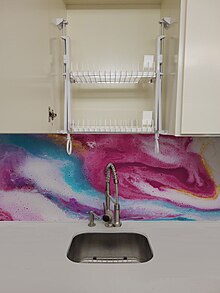
A 19-inch rack is a standardized frame or enclosure for mounting multiple electronic equipment modules. Each module has a front panel that is 19 inches (482.6 mm) wide. The 19 inch dimension includes the edges or ears that protrude from each side of the equipment, allowing the module to be fastened to the rack frame with screws or bolts. Common uses include computer servers, telecommunications equipment and networking hardware, audiovisual production gear, music production equipment, and scientific equipment.

A Petri dish is a shallow transparent lidded dish that biologists use to hold growth medium in which cells can be cultured, originally, cells of bacteria, fungi and small mosses. The container is named after its inventor, German bacteriologist Julius Richard Petri. It is the most common type of culture plate. The Petri dish is one of the most common items in biology laboratories and has entered popular culture. The term is sometimes written in lower case, especially in non-technical literature.

Lutefisk is dried whitefish. Usually cod is used, but ling and burbot are also used. It is made from aged stockfish, or dried and salted cod, cured in lye. The fish adopts a gelatinous texture after being rehydrated for days prior to eating.

A dishwasher is a machine that is used to clean dishware, cookware, and cutlery automatically. Unlike manual dishwashing, which relies on physical scrubbing to remove soiling, the mechanical dishwasher cleans by spraying hot water, typically between 45 and 75 °C, at the dishes, with lower temperatures of water used for delicate items.

A sink is a bowl-shaped plumbing fixture for washing hands, dishwashing, and other purposes. Sinks have a tap (faucet) that supply hot and cold water and may include a spray feature to be used for faster rinsing. They also include a drain to remove used water; this drain may itself include a strainer and/or shut-off device and an overflow-prevention device. Sinks may also have an integrated soap dispenser. Many sinks, especially in kitchens, are installed adjacent to or inside a counter.

Pudding is a type of food. It can be either a dessert or a savoury dish served as part of the main meal.

Finnish cuisine is notable for generally combining traditional country fare and haute cuisine with contemporary continental-style cooking. Fish and meat play a prominent role in traditional Finnish dishes in some parts of the country, while the dishes elsewhere have traditionally included various vegetables and mushrooms. Evacuees from Karelia contributed to foods in other parts of Finland in the aftermath of the Continuation War.

A pantry is a room or cupboard where beverages, food, (sometimes) dishes, household cleaning products, linens or provisions are stored within a home or office. Food and beverage pantries serve in an ancillary capacity to the kitchen.
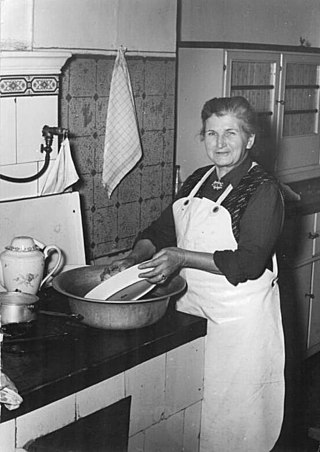
Dishwashing, washing the dishes, doing the dishes, or washing up in Great Britain, is the process of cleaning cooking utensils, dishes, cutlery and other items to prevent foodborne illness. This is either achieved by hand in a sink using dishwashing detergent or by using a dishwasher and may take place in a kitchen, utility room, scullery or elsewhere.

In great houses, scullery maids were the lowest-ranked and often the youngest of the female domestic servants and acted as assistants to a kitchen maid.

Beef Wellington is a steak dish of English origin, made out of fillet steak coated with pâté and duxelles, wrapped in puff pastry, then baked. Some recipes include wrapping the coated meat in a crêpe or dry-cured ham to retain the moisture and prevent it from making the pastry soggy.

Josephine Garis Cochran was an American inventor who invented the first successful hand-powered dishwasher, which she designed and then constructed with the assistance of mechanic George Butters, who became one of her first employees.

Arab cuisine is the cuisine of the Arab world, defined as the various regional cuisines of the Arab people, spanning from the Maghreb to the Fertile Crescent and the Arabian Peninsula. These cuisines are centuries old and reflect the culture of trading in ingredients, spices, herbs, and commodities. The regions have many similarities, but also unique traditions. They have also been influenced by climate, cultivation, and mutual commerce.
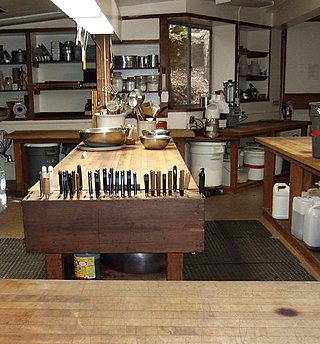
Kitchen cabinets are the built-in furniture installed in many kitchens for storage of food, cooking equipment, and often silverware and dishes for table service. Appliances such as refrigerators, dishwashers, and ovens are often integrated into kitchen cabinetry. There are many options for cabinets available at present.
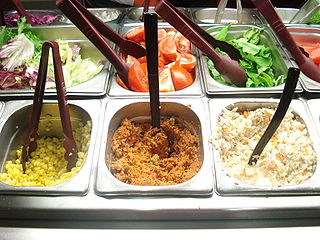
Gastronorm (GN), sometimes spelled Gastro-Norm, is a European standard for kitchenware tray and container sizes that is commonly seen worldwide in the catering and professional food industry, as well as in certain parts of the high-end consumer market. Gastronorm is generally used worldwide except in most of the United States and Canada, which have their own domestic systems. The gastronorm standard was first introduced in Switzerland in 1964 and became an official European standard in 1993 with the EN 631 standard.

The Sneath Glass Company was an American manufacturer of glass and glassware. After a brief 1890s startup in Tiffin, Ohio, the company moved to Hartford City, Indiana, to take advantage of the Indiana Gas Boom. The small city was enjoying the benefits of the boom, and could provide natural gas as an energy source for manufacturers. Sneath Glass was one of many glass manufacturers that moved to the region, and became Hartford City's second largest employer.

A soap dish is a shallow, open container or platform where a bar of soap may be placed to dry after use. Soap dishes are usually located in or near a sink, shower, or bathtub. Most soap dishes are made from waterproof materials such as plastic, ceramic, metal, or glass, though some are made from bamboo. A china saucer or sponge may serve as a soap dish. A soap dish accommodates bar soap, whereas a soap dispenser accommodates liquid soap or foam soap.

Sanna Mirella Marin is a Finnish politician who served as prime minister of Finland from 2019 to 2023 and as the leader of the Social Democratic Party of Finland (SDP) from 2020 to 2023. She was a Member of Parliament from 2015 to 2023. She is still actively involved in the Finnish local politics as a member of the Tampere city council. She resigned from her position in the Finnish parliament to start as a strategic adviser on political leaders' reform programmes in the Tony Blair Institute in September 2023.

A dishwasher is a person who washes and dries dishware, cookware, and cutlery, often in a "back of house" restaurant or institutional setting.
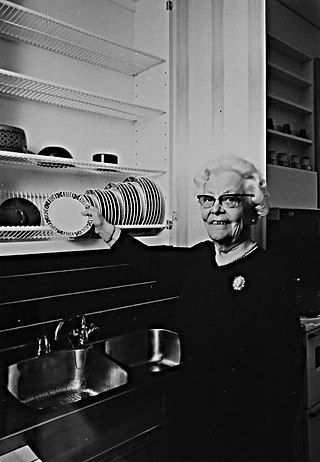
Maiju Gebhard was a Finnish inventor who invented the dish drying cabinet as the head of the household department at the Finnish Work Efficiency Institute in between 1944 and 1945. She was a daughter of economist Hannes Gebhard and politician Hedvig Gebhard.

